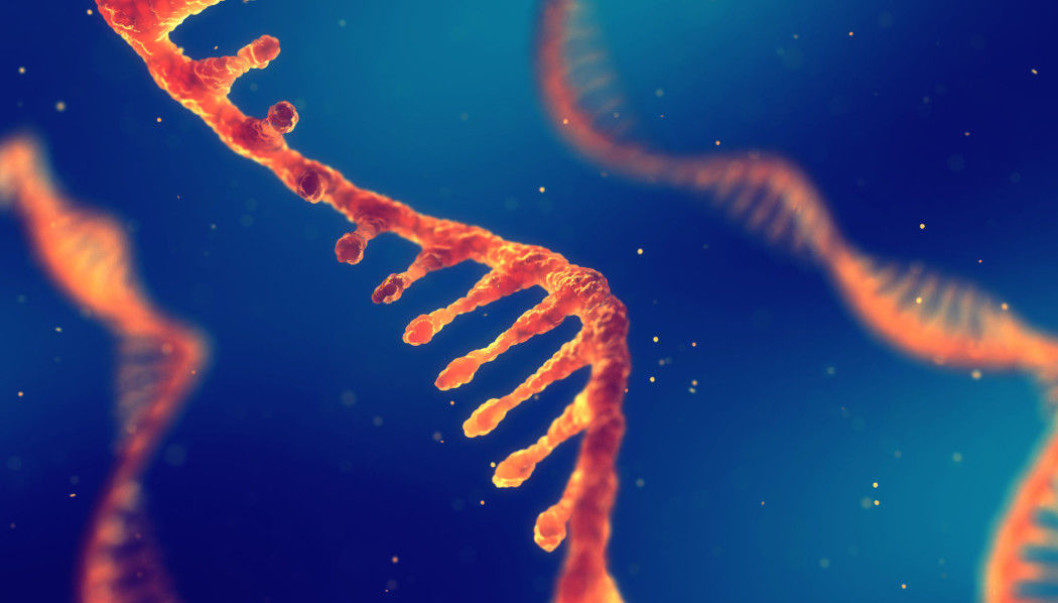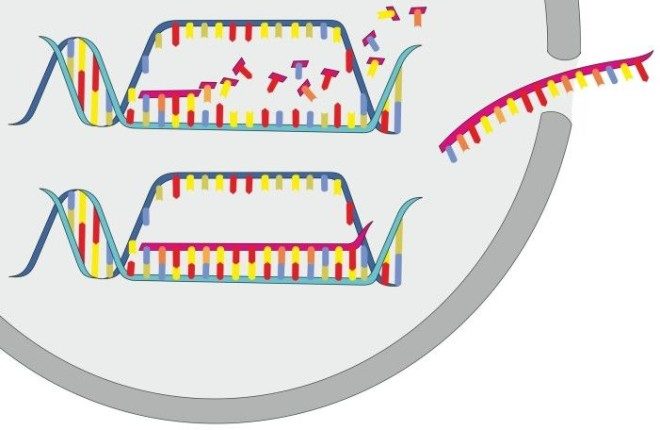
Just a few years ago, scientists began to realize that our genes, neatly written with chemical letters in our DNA, are actually not carved in stone.
Although genes themselves don't change, they can be regulated.
They are turned on and off as we grow and develop. These changes are influenced by our surroundings, so we actually change over the course of our lives. And some of these changes in regulation are passed on to our children.
Figuratively speaking, our DNA can be described as the recipe book for who and how we are, while epigenetic regulation can be seen as notes that have been pencilled into the margin.
Epigenetics thus describes a fascinating layer of information and regulation of our genes that enables us to adapt to new environments much faster than via normal evolution.
But lately, scientists have seen evidence of something more.
Another layer.
This time it's not about DNA, but about RNA, says Professor Arne Klungland at the University of Oslo.
"There has been an extreme interest in this field over the last five years," says Klungland, who himself leads one of the few research groups in the world that has worked in the field for a long time.
Chemical letters in our DNA
DNA usually gets all the attention in textbooks and in popular science.
The DNA molecule is an incredibly long double strand, made up of billions of so-called nucleotides. The nucleotides act like chemical letters with which all the genetic information in our genetic material is written.
Genes that control everything from eye colour to personality lie like chapters in a book along the double strand. The sequence of letters in our genes describes all the different proteins the body needs to execute the instructions that each gene contains.
But a recipe in itself is neither food nor life. So how is it that the instructions in our DNA are translated into action?
This is where RNA comes in.
RNA brings the recipe to life
RNA, short for ribonucleic acid , is a small molecule that is similar to DNA. It has only one strand, but also contains a series of chemical letters, like DNA.
One kind of RNA molecule is created as a piece of the DNA molecule, and works like a kind of sticky note.
When this happens, the RNA unzips the DNA so that the two DNA strands are split into a small segment. Then an RNA molecule is created that contains the recipe for a protein.
Afterwards, the RNA takes this copy to the parts of the cell that can make proteins based on the recipe that was copied. A subset of RNA also helps create the protein itself.

Initially, researchers thought that RNA worked like a dutiful but slightly boring cook, one that follows the recipe exactly.
But lately, scientists have begun to rethink this idea. RNA appears to be making its own modifications to the DNA recipes.
RNA labels
Decades ago, scientists first discovered that RNA molecules can have modifications, in that they can also have chemical tags attached to them.
But for a long time, there were no good ways to investigate these little tags on the RNA, or to understand how common they were and where they were found. As a result, this discovery was more or less forgotten.
In 2008, however, Chuan He, a researcher from the University of Chicago, studied selected types of enzymes, substances that can cut and paste in other molecules. The researchers thought these enzymes could cut off the epigenetic labels in the DNA.
But their studies showed that several of the enzymes did not appear to act on DNA. This was especially true for one of them, called FTO.
On the trail of a new regulatory system?
Different variants of the gene for this enzyme are linked to obesity. FTO seems to play a very important role in the body and we cannot live without it. But it did not appear to have any effect on DNA.
That's when the researchers thought, maybe it works on RNA instead?
And if so: Did this mean that little labels on RNA could also be cut away? That is, could modifications to RNA be attached and removed, just like epigenetic labels can turn genes on and off in DNA?
If this turned out to be true, scientists could be on the cusp of a completely unknown regulatory system in the cells, as well as in epigenetics.
Epitranscriptomics
In 2011, He and his colleagues published research that suggested that the enzyme FTO could actually remove labels from RNA.
And a few years later, several research groups had devised techniques for mapping and investigating a type of RNA modification, called 6-methyladenine (m6A).
Three different studies, including one that Klungland was involved in, made it clear that these changes could be turned on and off.
The m6A tags were attached to specific regions of RNA and appeared to be important. Attaching and removing m6A at the right time seemed to be absolutely necessary in some situations, such as in foetal development.
Gradually, more and more scientists have begun to believe in the existence of something they call epitranscriptomics — that is, epigenetics for RNA, which in turn affects how the information in our DNA is used in practice.
Possibility of rapid, but temporary changes

"Together, these new studies reveal a whole new level of gene expression regulation," wrote Margarita Angelova and her colleagues in Frontiers in Bioengineering and Biotechnology in 2018.
At the same time, researchers have warned that so far, we know very little about what these modifications are doing.
In addition to m6A, researchers have found about 150 other alterations to RNA. Klungland agrees that there's a lot we don't know, such as what actually controls these alterations.
"Epigenetic changes in DNA are clearly influenced by the environment, but we do not know if this is the case with modifications in RNA," he says. "I wouldn't be surprised if the environment was also controlling RNA modification, but this is difficult to study."
Unlike DNA, RNA in a cell is volatile. The RNA molecules are formed and dissolved in one go. This makes it much more difficult to assess them to find out how they behave and what affects them.
"But it's conceivable that these RNA modifications are a way to make rapid, temporary changes in how genes are expressed," says Klungland.
Cancer is a hot topic
Klungland is confident that there will be an increasing number of new studies on epitranscriptomics in the next few years. Many will fall under the rubric of basic research and will tell us more about how this newly discovered regulatory system works.
But we can also expect studies that link RNA modifications to disease.
"RNA and cancer development is a hot topic," he says. "For example, there's evidence that changes in RNA can prevent the growth of cancerous tumours."
Various biotechnology companies have already started to search for medicines that can affect the regulation of RNA, but the road to effective treatment is likely to be very long.
Quite basic
Klungland and his colleagues have recently published research showing that modifications to RNA must be correct for DNA to work.
A special m6A modification is needed when RNA separates the strands in DNA and copies a recipe. But it is equally important that the tag be removed again afterwards. If not, the DNA can be damaged.
Both mice and humans get sick if RNA tags aren't added and removed at the right time, he said.
"This can lead to both cancer and neurodegenerative disease," Klungland says.
When he and his colleagues did an experiment where RNA modifications were not read properly, it turned out that fertilized eggs in live mice were unable to develop.
This means that changes in RNA are a fundamental function of the body. A fundamental mechanism that was completely unknown just a few years ago.



We appreciate it!